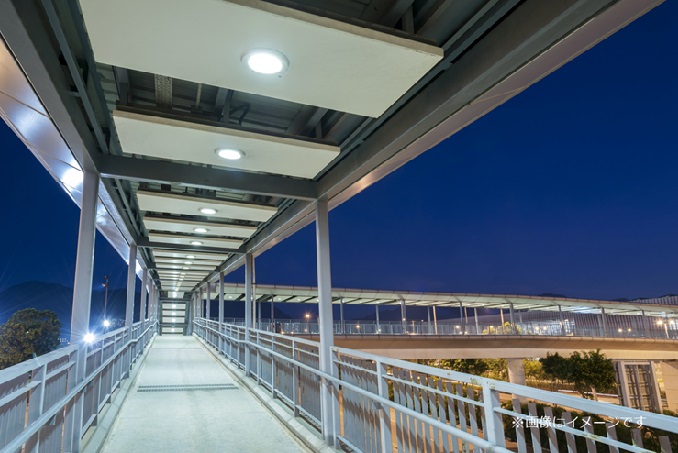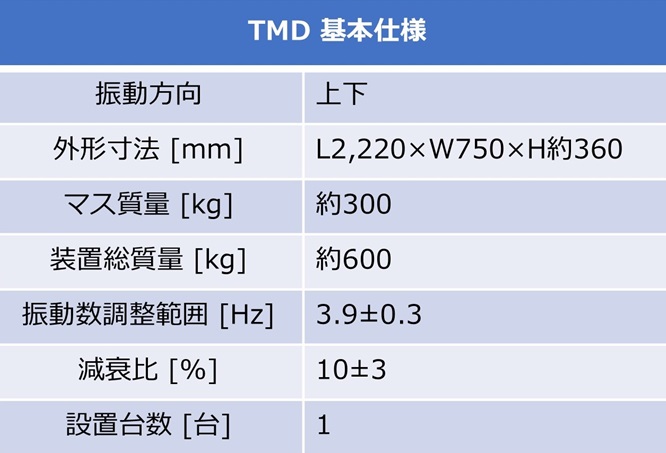Demonstrated in a multi-person walk! Vibration Damping Device (TMD) Improves Large Sway in Crossing Corridor

In a corridor used by many people, there was concern about swaying due to resonance during walking. While structural constraints made it difficult to install columns, a vibration control device (TMD: tuned mass damper) was installed to suppress swaying even when many people were walking, ensuring comfort and usability.
Engineering Group, Division 1
Ryosuke Ito
Issues in this case study
One factory was planning to construct a long-span corridor, approximately 22 meters long, connecting the company building to the factory area (Figure 1).
In general, crosswalks and pedestrian bridges tend to have long spans, so they tend to resonate with the gait of pedestrians, which amplifies sway and can cause discomfort.
In this case, the structural analysis by the designer indicated that the natural frequency of the crosswalk was approximately 4 Hz. This frequency tends to coincide with the second harmonic component of walking, and there was concern that the center of the corridor might sway significantly due to resonance during walking.
In addition, since it was assumed that many people would use this crossing corridor during breaks, etc., there was a high possibility that the shaking would be even greater, and measures were needed from the standpoint of comfort and usability.
The first possible measure would be to install pillars in the center where the swaying occurs. However, the lower part of the corridor is a roadway, making it difficult to install pillars, so another countermeasure was needed.

Figure 1: Image of a corridor
Vibration control by vibration damping device (TMD)
Because structural measures were difficult to implement, this case study used a vibration control device (TMD) (Figure 2, Table 1).
Resonance phenomena caused by walking vibration can be effectively addressed by vibration control devices such as TMDs and AMDs that respond to specific vibration frequencies and suppress swaying.
In this project, one TMD with a vibrating mass of 300 kg was installed under the floor in the center of the crosswalk to reduce sway due to resonance (Figures 3 and 4).

Figure 2: Appearance of TMD
Table 1: TMD Basic Specifications


Figure 3: TMD installation location

Figure 4: TMD installation status (red-colored area)
TMD effectively suppresses swaying by matching the natural frequency of the vibration control target with the frequency of the TMD. First, to determine the natural frequency of the corridor, heel vibration was applied to the center of the corridor and the response acceleration was measured. As a result, a peak was observed at 4.2 Hz, which was found to be the natural frequency of the corridor. Based on these measurements, the vibration frequency of the TMD was adjusted to obtain the optimal vibration control effect (Figures 5 and 6).

Figure 5: Measured response vibration acceleration when heel excitation is applied to a cross corridor

Figure 6: TMD frequency adjustment
Vibration control effect of TMD installation
First, measurements were taken by heel excitation to confirm the vibration-damping effect of TMD. In the case of non-vibration control (TMD_OFF), the shaking continued after excitation, whereas in the case of vibration control (TMD_ON), the shaking quickly subsided, confirming that the TMD was functioning effectively (Figure 7).

Figure 7: Time history response results for non-vibration control and vibration control during heel excitation
Next, we conducted walking excitation measurements with a large number of people to simulate actual usage conditions.
Twenty-six people lined up in two rows of thirteen pairs, equally spaced, and walked from Building E to the company building side. The tempo of the walk was set to 1/2 the natural frequency of the corridor using a metronome (Fig. 8).

Figure 8: Image of 26-person walking excitation measurement
The measurement results showed that in the 1/3-octave band at 4 Hz when the vibration was not controlled, 31.3 cm/s2After vibration control, the vibration was 9.6 cm/s.2and reduced to about 1/3 (Table 2).
Pedestrian Bridge Guidelines※ 1In the evaluation curve of the "I feel it clearly" to below "I feel it a little" for those in the walking state, and improved from above "I feel it clearly" to "I feel it a little" for those in the standing still state (Fig. 9).
Even under the condition of multiple people walking at the same time, the installation of TMDs reduced swaying during walking and ensured comfort and usability.
1 "Pedestrian Bridges in the Future - Guidelines for Planning and Design of Pedestrian Bridges that are Attached and Friendly to People," Japan Steel Structure Association, ed.

Figure 9: Measured results of effectiveness confirmation by 26 people walking (pedestrian bridge design guidelines)
Table 2: Comparison of non vibration control and vibration control evaluations based on pedestrian bridge design guidelines.

